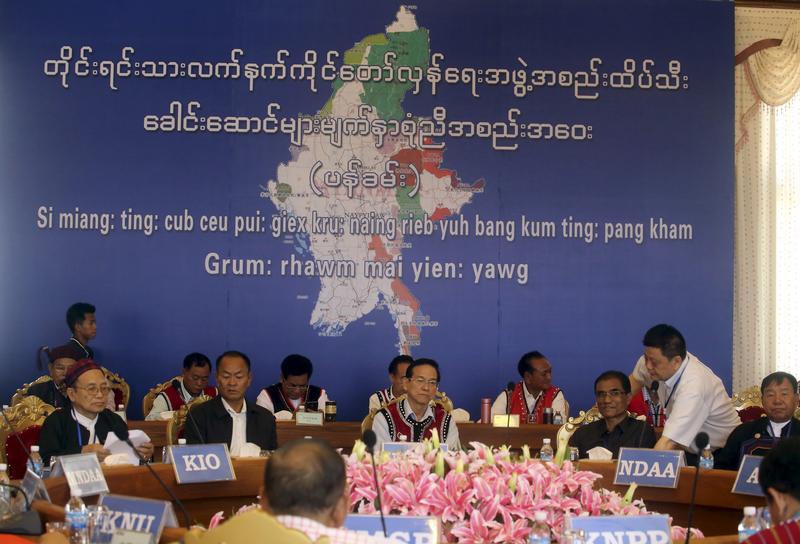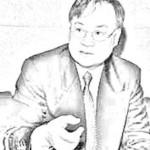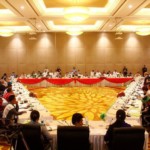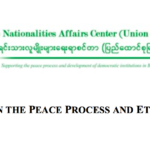Angshuman Choudhury / Democratic Voice of Burma (DVB) | November 30, 2017
On 11-12 November, a delegation of senior government officials led by the Union Minister for Border Affairs, Lieutenant-General Ye Aung, met with members of Burma’s largest ethnic armed organisation (EAO), the United Wa State Army (UWSA), and its smaller ally, the National Democratic Alliance Army (NDAA), also known as the Mongla Army, in the de facto Wa capital of Panghsang and Mongla Special Region-4, respectively. A large part of the discussions involved each party laying on the table their agenda for the ongoing ethnic peace process.
This was a much-awaited icebreaker that came months after failed attempts by Naypyidaw to arrange talks with the northern groups that continue to dismiss the Nationwide Ceasefire Agreement (NCA) — the foundation of the current peace process — and flag their alternative framework for dialogue under a new alliance of seven non-ceasefire EAOs, known as the Federal Political Negotiation and Consultative Committee (FPNCC).
The discussions that transpired indicate how differently the northern groups perceive the peace process and the federal imagination as compared to the Union centres of power. Clearly, the FPNCC is a fresh challenge for the government, and could decisively stymie the already jittery relationship between the civilian government of State Counsellor Aung San Suu Kyi, the Tatmadaw (Burma’s military), and the non-ceasefire EAOs.
Insofar as the Union government’s agenda for ethnic reconciliation is concerned, there is little doubt that the north, where the most powerful rebel armies operate, holds the key to a permanent negotiated settlement. There are few regions in the country where the need for de-escalation is as urgent as in the north, which has been ravaged by unprecedented levels of conflict for the past two years. Yet, the conditions for peace remain as obscure as ever — a point only reaffirmed by the recent meeting.
What happened at the meeting?
First, the FPNCC expressed that it wants to follow its own dialogue framework while the government and Tatmadaw have insisted that all parties stick to the NCA. The two processes seem to be at serious loggerheads, especially in light of the recently released FPNCC charter that proposes extensive devolution of powers to individual “nations” within the Union — an agenda that radically challenges the centripetal sentiments of Naypyidaw’s ruling elite. There is little chance that the Tatmadaw would take up such a decentralised model for discussion anytime soon.
Second, the UWSA and NDAA insist that the government talk to them as a single group (i.e., as the FPNCC) along with the other EAOs, but the government/Tatmadaw side prefers individual meetings for reasons that are fairly obvious. Talking to FPNCC members as a group would mean legitimising the existence of the alliance. From Naypyidaw’s point of view, this would mean ceding space to the UWSA as a parallel agenda-setter in Burma’s contested ethnic polity, in addition to creating an additional dialogue channel.
Third, the UWSA demanded that the government revoke the “terrorist” designation slapped on three members of the FPNCC — the Arakan Army (AA), the Ta’ang National Liberation Army (TNLA) and the Myanmar National Democratic Alliance Army (MNDAA) — through a motion passed in the Shan State legislature in December 2016. Since the Union government asserts that it has a policy of not negotiating with terrorists, it remains unclear as to under what conditions talks with these groups would proceed.
Revocation of the label could take time, as Shan State is politically split between Suu Kyi’s National League for Democracy (NLD) and the pro-military Union Solidarity and Development Party (USDP), with the former heading the state government and the latter dominating the state legislature.
Fourth, the UWSA used the meeting to forward a set of specific demands to the Union government, relating to central funds for public infrastructure projects, hydropower plants and national ID cards for Wa-controlled areas. This could imply that the UWSA is using the FPNCC, or rather the entire peace process, to create new bargaining chips and thus, secure the future of its own autonomous enclave.
The FPNCC charter: An irreconcilable framework?
The FPNCC appears to have organised itself very well, down to a neat website and a bilingual charter with a rambling title: “The General Principles and Specific Propositions of Revolutionary Armed Organisations of All Nationalities Upon the Political Negotiation.” This document posits a radical political vision for a federal Burma, including a host of specific demands for structural reformation that, for now, appear irreconcilable with the Union-centric political visions of the civilian government and the Tatmadaw.
The FPNCC charter uses the term “Revolutionary Armed Organisation” in place of EAO. While this might be a minor terminological change, it is a clear attempt to separate themselves from other negotiating parties and wrest the discursive monopoly over the entire peace process from the Union government and Tatmadaw. If the idea is to create a fool-proof alternative to Naypyidaw’s peace designs, then altering the specifics is indeed an effective starting point.
The charter posits total devolution of centralised authority to ethnic “nations,” down to the domains of foreign policy, border security, choice of currency, industrial policies and cultural education. While the current federal structure does allow for a significant degree of politico-economic autonomy to states, the FPNCC’s proposal talks of the kind of decentralisation that Burma has never seen before. These aptly encapsulate the longstanding political imagination of peripheral ethnic groups — also captured in the “Panglong Spirit” — who have traditionally distinguished themselves from the country’s Bamar majority.
Another remarkable proposition enshrined in the FPNCC charter is the nationalisation and depoliticisation of the Tatmadaw. Although the committee recognises the institution as an “important force to ensure the national security of the Union of Myanmar,” it wants the army to stay away from the political affairs of the Union or its constituent nations and only serve as a professional national defence force. It also seeks to remove the army’s 25 percent fixed seat quota in the Parliament. However, for an institution whose roots run deep into the state apparatus, courtesy of 60 years of totalitarian rule, these propositions could appear ludicrous and even infuriating. There is little possibility that the generals would cede all political space to the civilian government at this moment or permit states to manage international borders, particularly in light of the simmering conflict in northern Rakhine State.
Intriguingly, the opening paragraph of Part Two of the charter states that the “Wa is willing to work with the Union government, Tatmadaw, and fraternal ethnic groups to discuss the principles of national reconciliation, peace, and a new Union of Myanmar.” This is the only instance in the entire document where the name of an individual FPNCC member appears, that too in the clear capacity of a representational authority. In itself, it gives the impression that the Wa might be single-handedly setting the group’s agenda, perhaps in an undemocratic fashion.
Untying the knot
The Union government and the Tatmadaw, instead of hammering the NCA on the northern groups, need to realise that the FPNCC is a reality and isn’t going to go away anytime soon.
First, the government and Tatmadaw must engage with the FPNCC on an informal level, preferably through backchannels. This would clarify the multivariate agendas on the table and open discussions on the alliance’s charter, while also not putting an official stamp on the alliance. An obvious mediator in this case would be China. The northern groups are already in constant touch with the Chinese special envoy for Asian affairs with regard to convening meetings and engaging with Naypyidaw. This critical political leverage could be the Burmese government’s much-needed foot-in-the-door into the restive north.
Second, the Union government and Tatmadaw must urgently engage with lawmakers in Shan State to break the deadlock over designating the AA, TNLA and MNDAA as “terrorist organisations.” In this case, the Tatmadaw could use its influence over the USDP to pass an overriding motion. These three hostile groups, along with the Kachin Independence Army (KIA), constitute the “Northern Alliance,” an insurgent sub-alliance that maintains an offensive posture on the ground. Hence, without getting them on board, there can be no peace in the north.
Third, if the Union government genuinely wants the northern groups to abandon their alternate path to reconciliation and join the NCA process, then it must offer solid incentives. A core part of this incentivisation process would be reforming the NCA framework to permit willing northern groups to convene national-level dialogues in their respective ethnic quarters and thereafter, incorporate the outcomes into the upcoming Union Peace Conference. This would allow the EAOs to consult their own people and even bridge some of the critical trust deficits between Naypyidaw and the north.
The government needs to bring a host of non-Track 1 actors on board the dialogue process, in the likes of think-tanks, community organisations, religious bodies and other civil society actors. This multi-track engagement could be effective in hashing out the complex details and extremities of the FPNCC’s radical agenda and, eventually, arriving at a middle ground. This is largely because what the FPNCC charter talks about isn’t new, but rather the longstanding collective aspirations of the frontier peoples. Without negotiating with them, Naypyidaw will remain leagues away from a permanent solution to the “ethnic problem.”
For now, Burma’s peace process remains held back by the northern fix. There is an immediate need for every negotiating party to identify common agendas and the median point for further negotiations. Without deeper and broader engagement with all actors, beyond the parochial politics of it all, the revitalised Panglong process will remain a half-baked dream.
This article originally appeared on Tea Circle on November 28, 2017 and was published on DVB on November 30, 2017.







